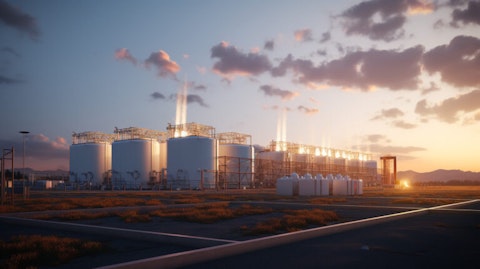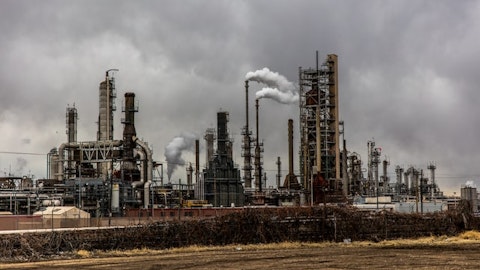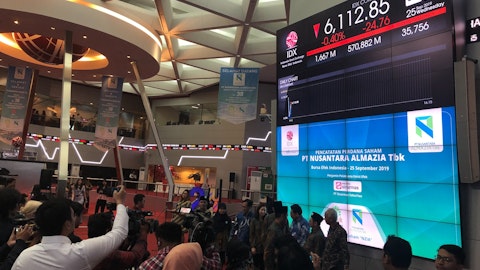PBF Energy Inc. (NYSE:PBF) Q3 2023 Earnings Call Transcript November 2, 2023
PBF Energy Inc. beats earnings expectations. Reported EPS is $6.61, expectations were $4.62.
Operator: Good day, everyone, and welcome to the PBF Energy Third Quarter 2023 Earnings Conference Call and Webcast. [Operator Instructions] Please note this conference is being recorded. It is now my pleasure to turn the floor over to Colin Murray of Investor Relations. Sir, you may begin.
Colin Murray: Thank you, Devlin. Good morning and welcome to today’s call. With me today are Matt Lucey, our President and CEO; Karen Davis, our CFO; Tom Nimbley, our Executive Chairman; and several other members of our management team. Copies of today’s earnings release and our 10-Q filing, including supplemental information, are available on our website. Before getting started, I’d like to direct your attention to the safe harbor statement contained in today’s press release. Statements in our press release and those made on this call that express the company’s or management’s expectations or predictions of the future are forward-looking statements, intended to be covered by the safe harbor provisions under federal securities laws.

A storage facility for natural gas, showing the vast reserves of this abundant energy source.
There are many factors that could cause actual results to differ from our expectations, including those we described in our filings with the SEC. Consistent with our prior periods, we’ll discuss our results today, excluding special items. In today’s press release, we describe the non-cash special items included in our quarterly results. The cumulative impact of these special items decreased third quarter net income by an after-tax amount of $65 million or $0.50 a share, primarily related to a change in the fair value of the contingent consideration associated with the Martinez acquisition, loss on extinguishment of debt, and exit costs associated with the early termination of the Inventory Intermediation Agreement. Also included in today’s press release is further guidance information related to our expectations for the remainder of 2023 operations.
For any questions on these items or follow-up questions, please contact Investor Relations after the call. For reconciliations of any non-GAAP measures mentioned on today’s call, please refer to the supplemental tables provided in today’s press release. I’ll now turn the call over to Matt Lucey.
Matthew Lucey: Good morning, everyone, and thanks for joining the call. Today, PBF reported another quarter of strong results, our third strongest quarter in our history, I believe; driven by robust refined product markets that dominated most of the quarter. Our refineries ran reasonably well with no major planned outages at any of our facilities during the quarter. Now that we are in the shoulder season, we’ve seen gasoline cracks come off, but as expected, diesel margins have remained robust as inventories are tight. Despite the recent pullback in gasoline, we expect that prices will stabilize and compound cracks, on average, will remain above previous mid-cycle levels as they are today. The pricing environment will continue to remain volatile.
However, PBF is well positioned to respond to these market conditions with our high complexity, high conversion refining footprint. With respect to capital allocation, our core principle is to create a competition for capital in which capital flows to its highest and best use. As we’ve stated previously, our first priority was to strengthen and simplify our balance sheet. We operate in a cyclical business and a strong balance sheet is imperative in managing the inevitable market cycles. At this point, we have an investment-grade balance sheet that ranks among the strongest in our peer group. With balance sheet substantially behind us, PBF will continue to weigh investments in growth against returning capital to shareholders and our allocation of excess cash.
A year ago, we reinstated our dividend. This week, our Board approved a $0.05 per share increase in the quarterly dividend to $0.25 per share. Going forward, further potential dividend increases will be evaluated on an annual basis. In the fourth quarter of ’22, we announced a $500 million share buyback program and then increased the authorization to $1 billion in May. From inception of the buyback program in December through today, we have deployed $590 million in cash, repurchasing 14 million shares or 11% of the shares outstanding. Going forward, we expect to remain active in buying back shares. The ultimate level of buyback activity will be determined by the excess cash generation of our business, coupled with a rigorous evaluation of reinvestment opportunities relative to share buyback economics.
Investments in growth will be disciplined and will leverage PBF strengths. We have no plans to get bigger for the sake of getting bigger. Diversification will not be pursued for the sake of diversification. Our goal is to leverage our core strength in assets and expertise to make investments in complementary businesses with compelling risk return ratios. Perfect example of this blueprint is our investment in St. Bernard Renewables, where we leveraged an idled asset and our expertise in fuels manufacturing into a compelling renewable diesel joint venture with a world-class partner in Eni. Turning to renewable diesel, we are pleased to announce that in the first full quarter of operations, St. Bernard Renewables has reported positive earnings.
We continue to line out operations post RDU start-up in June and the PTU start-up in late July. We did advance a catalyst change on the RDU into the fourth quarter as we work to optimize the assets. We are more than pleased to have gotten to this point working alongside our joint venture partner, Eni Sustainable Mobility, as we continue exploring opportunities to expand our partnership. Furthering PBF’s participation in the future of energy, the U.S. Department of Energy recently selected MACH2 project as the regional hydrogen hub that will receive funding under the IRA. Although there is still a lot of ground to cover, we are pleased to be part of the consortium that will advance this project and ultimately supply hydrogen as a clean energy transportation fuel.
Looking ahead to the fourth quarter, we’re in the midst of planned maintenance at Torrance on the FCC and outpacing units, and we’re doing additional work on the Martinez flexicoker. The flexicoker work was unplanned and the downtime from both Torrance and Martinez will impact fourth quarter capture rates on the West Coast. The good news is that Martinez work should be complete in the next week or so and Torrance work should be complete before the end of the month. As we saw from activity early in the quarter, commodity markets will continue to be volatile. The global refining system, and PBF in particular, will be nimble in adapting to market conditions. Before I turn the call over to Karen, I want to repeat the tailwinds that we currently see for PBF.
First, our complex, predominantly coastal coking refining system is well situated for the current marketplace. Second, maybe most importantly, the transformation of our balance sheet is now complete. We have reduced and extended our gross debt, we bought in the intermediation agreement, and as of today, we have essentially extinguished our outstanding RIN obligation. We’ve reinstated now, increased our dividend, implemented a share repurchase program and are now producing renewable fuels and have also been selected as part of the growing hydrogen economy with the MACH2 project. These are all tailwinds that PBF has had a direct hand in creating and will help drive long-term value. With that, I’ll turn it over to Karen.
Karen Davis: Thank you, Matt. For the third quarter, we reported adjusted net income of $6.61 per share and adjusted EBITDA of $1.3 billion. This includes approximately $14.6 million generated from our equity interest in SBR. Also included in our results is an approximate $100 million benefit from the market decline in the price of renewable energy credits, which is captured in our gross margin. Cash flow from operations for the quarter was $1.15 billion, excluding working capital changes. Working capital was a headwind of $618 million for the quarter, mostly related to our continued efforts to strengthen and simplify our balance sheet. Those efforts in the third quarter included exiting our Inventory Intermediation Agreement in July at a total cost of $268 million.
And second, we further reduced our outstanding environmental payables by $339 million. That brings the total reduction in our environmental credit liability to over $900 million for the year-to-date. The liability totaled $454 million as of September 30. One comment on our Outstanding Environmental Payables, in our previous calls, we mentioned a normalized range of payables of approximately $200 million to $400 million. Recently, we have seen that the price of environmental credits can indeed come down. This impacts the dollar range previously provided. Going forward, we suggest thinking about our normalized payables as reflecting approximately two to four months of our net obligation. Taking into account the RINs we are buying from SBR, our normalized environmental payables will likely reflect a balance of approximately $50 million to $100 million RINs. This range may fluctuate depending on market conditions and commercial strategy.
We further strengthened the balance sheet during the quarter by reducing our gross debt by approximately $170 million, primarily through issuing $500 million in 2030 notes and calling the remaining balance of our 2025 notes. Of note, with the issuance of our new 2030 notes in August and redemption of the 2025 notes, we have no near-term debt maturities, and we also increased the size of our undrawn ABL facilities to $3.5 billion and extended the maturity to 2028. Consolidated CapEx for the third quarter was approximately $190 million, which includes $155 million for refining, corporate and logistics and approximately $35 million related to SBR. For the entirety of 2023, we expect PBF Energy CapEx, excluding SBR, to be approximately $800 million to $850 million.
This is above the previously provided range, primarily due to the increased scope of work for our ongoing West Coast turnaround and advanced purchases of long lead items for planned 2024 turnarounds. Also during the third quarter, we received $415 million in proceeds related to the SBR joint venture, bringing total proceeds received related to our investment in SBR to $845 million. We continue to demonstrate our commitment to shareholder returns through our quarterly dividends and share repurchase program. Dividends paid during the third quarter totaled $27 million. And as Matt mentioned, we just announced an increase in our quarterly dividend from $0.20 to $0.25. With respect to our share repurchase program, of the almost $590 million of total repurchases to-date, $115 million was executed in the third quarter.
For the life of the program, as of October 31, we have repurchased almost 14.3 million shares and reduced our total share count to just under 122 million shares. We view dividends and share repurchases as important components of our overall long-term capital allocation and shareholder return objectives. Our G&A expenses for the third quarter came in at $93 million, which includes our base G&A expense and amounts related to the company’s incentive and equity-based compensation plans. As mentioned last quarter, depending on financial and operational performance, there could be approximately $125 million to $175 million of incremental G&A expense annually related to our compensation programs, above our annual base G&A of approximately $225 million.
We ended the quarter with almost $1.9 million in cash and just over $1.2 billion of debt. We are retaining incremental cash above our previously guided ranges because it’s earmarked for future near-term uses, including higher turnaround activity in Q4, continued reductions in outstanding environmental payables and other current liabilities, and the final payment of the Martinez earnout early next year. We will continue to focus on maintaining a robust balance sheet and exercising sound financial policy. Our balance sheet and the safe operations of our assets are key priorities, while maintaining a disciplined approach to rewarding our shareholders. We believe our sector-leading balance sheet meets or exceeds many investment grade credit metrics, and we maintain our goal of eventually achieving investment-grade status.
Operator, we’ve completed our opening remarks and we’d be pleased to take questions.
See also 25 Best Selling Items on Facebook Marketplace and 25 Least Forested Countries in Europe.
Q&A Session
Follow Pbf Energy Inc. (NYSE:PBF)
Follow Pbf Energy Inc. (NYSE:PBF)
Operator: [Operator Instructions] Our first question comes from the line of Roger Read with Wells Fargo. Please proceed with your question.
Roger Read: Yes. Thank you. Good morning. And just say, congrats on the overall transformation. I mean, it wasn’t that long ago I assumed you were going to have to issue shares to keep the company solvent and now you’re in the process of returning this much cash to shareholders. So, great job there. My question, Matt, and you were alluding to a lot of it, maybe more than alluding during your comments, but growth, avoid growth for growth sake, avoid growth for diversification. But we also know that there’s a big option process for CITGO. What are your thoughts as you look at that or any other, let’s say, U.S. refining opportunity or maybe even more broadly North America, since there’s an East Canada unit that might be on the market as well?
Matthew Lucey: Thanks for the question and the comments, Roger. In regards to CITCO, it’s a quagmire. I mean, it’s in a court process. It’s within geopolitics you know all that thing thrown around. Quite frankly, I don’t think it’s worth talking about at this point. I don’t see any reason why. I anecdotally have read articles where the valuations, if they’re true, they’re exorbitantly more than what PBF is being valued today. So, I hope it’s true because it means our company is worth a lot more and the shares that we’ve been buying over the last year are going to be worth a lot more. So, I don’t think there’s anything to comment on in regards to CITCO in particular. I have no idea where it’s going to go, and I don’t think it’s going to go anywhere in the near future.
My comments were specific for a reason in that, and I think our company has become much, much easier with its simple and pristine balance sheet that we have now. And so, anything that we look at has to have a compelling return aspect that is much more attractive than the shares that we’ve been buying and we bought almost 600 million shares – $600 million worth of shares over the last year. So, it becomes very, very simple. I can assure you, as I can assure the marketplace, we have – not only are we using the words rigor and discipline, but we’ve formalized an internal process so that everything will be down into an Excel model, making a mathematical calculation that shows the risk return results of all of our alternatives, and we’ll continue to execute that going forward.
Roger Read: Appreciate that. Follow-up question is on the SBR. Little guidance of some work coming here in the fourth quarter. But just stepping back, looking at the way this unit has started up where you’ve been able to move the product, how do things look today versus six months ago before start-up in terms of what you expected, what the budget looked like and kind of what’s been better or what’s been worse. We know a lot of others have had issues with start-up companies I’m just curious, they’re good, the bad and the ugly here?
Matthew Lucey: Yes. No, it’s good and it’s sort of multifaceted. So you have the base operation and then you have the marketplace. I can start with the marketplace. The way we think about those that are participating in renewable fuels within the diesel market, and I don’t want to confuse lingo here, but you have one end of the spectrum you’ve got biodiesel, maybe in the middle you have renewable diesel manufacturers that don’t have pretreatment units, and then you’ve got integrated pretreated or pretreatment units with the capability to manufacture renewable diesel. And then obviously, geography plays on that. With the fall in some of the regulatory credits, I think bio-based diesel manufacturing is threatened in the short term.
I think those that have a pretreatment facility and are able to run low-carbon fuels will be able to operate profitably, but albeit at a lower margin than where it was a year ago. Obviously, there’s lots of dynamic factors in it. It’s not just the regulatory threads. But at the end of the day, I’m very, very confident that there will be a market incentive, a resilient market incentive for those with a pretreatment unit to manufacture renewable diesel. In regards to our operations, it’s no different than the start-up of probably any other operation. There’s fits and starts, there is pluses and minuses. All in all, we’ve been very pleased. We got our unit up in a time frame that was consistent with what we talked about. We did accelerate some catalyst work into the fourth quarter, which was earlier than we had planned.
But that’s all in an attempt to optimize the unit. That will impact Q4 operations clearly, because we have to take the unit down to do that. But as we’re working through it, as I said, I think we’re going to be able to improve on the throughput of the unit. So I think our capacity and we’re ultimately able to work through the unit, will probably be a positive surprise. I’m myopically focused on what the yields look like coming off the unit and they’ve been a little bit worse than we expected. So there’s pluses and minuses, but we’re working every day to make sure it’s optimized and we’re getting a huge benefit from our partners at Eni. They’ve got a couple of these facilities already. They have expertise. They have relationships with some of the service providers.
So it’s – I’m more than pleased with it in its entirety.
Roger Read: Great. Thank you.
Operator: Thank you. Our next question comes from the line of Doug Leggate with Bank of America. Please proceed with your question.
Doug Leggate: Thanks. Good morning, everyone. Matt, thanks for taking my questions. Phenomenal capture rate in the quarter, and I wonder if you could speak to the absence of, as you pointed out in your prepared remarks, any meaningful downtime? How unusual should we think this quarter looks versus the outlook? Or do you think a higher sustainable level of capture rate going forward? I think this is one of the highest I’ve seen in your history, frankly, how sustainable that might be? Has anything changed that reinforces your confidence that operational reliability is moved to a new level?
Matthew Lucey: Well, look, I think when you’re talking about work, you always have to look at the calendar and we obviously plan our work during periods where demand is not at its highest and it’s usually at its highest in the third quarter. So, by definition, you’re going to want the second quarter and third quarter to have less work. That being said, as much as it frustrates me, I would like to send a memo out and cancel all future work and just run, but that’s not possible. We do have turnarounds, that will happen in the first quarter. We will have turnarounds. But, like I said, usually you set your calendar up to match with what the market has traditionally been. So, in the fourth quarter, we have a big turnaround at Torrance.
I have to take a moment, Doug, and Tom Nimbley, who’s sitting here to the right, my right, has stated that what I’m about to say maybe 4,000 times, which is, you can never measure the success of a turnaround until the run is complete. And I do have to take a moment for the people in Torrance. We just ran the cat cracker at Torrance for eight years; a phenomenal run, phenomenal run. And if you’re able to do that, you reduce your CapEx on an amortized basis, you increase your uptime, and it’s really a great result. So they deserve a lot of credit and we intend to clearly communicate that to them. But that work is impactful in Q4, for sure. We did have an issue with our flexicoker, which, by the way, we had a turnaround on in – earlier in the year in the first quarter.
Part of the equipment that was untouched and it wasn’t touched because it shouldn’t have been touched. But we had an issue with a blower there. And, so, we’ve had to take that equipment down. That is probably a more – maybe the most complex unit we have in our entire system. So that was unfortunate and – but that’s being addressed. And like I said in my comments, we expect that to be up over the next week or so. But that also will have an impact on Q4.



